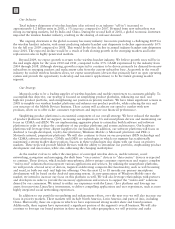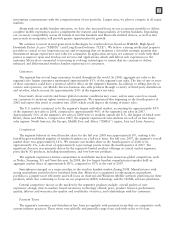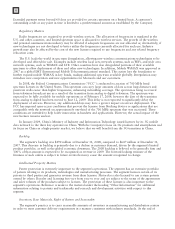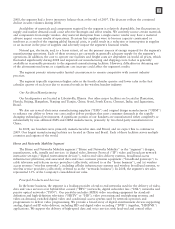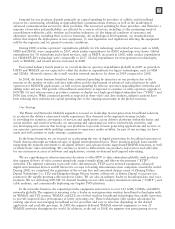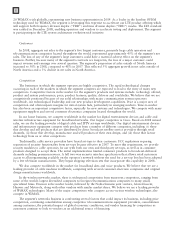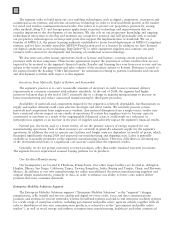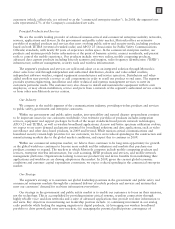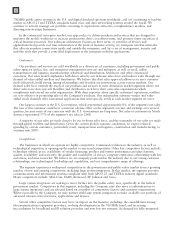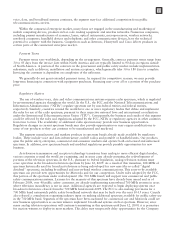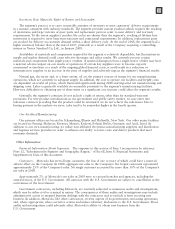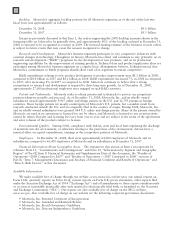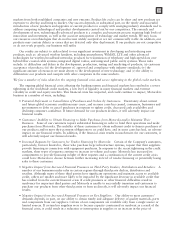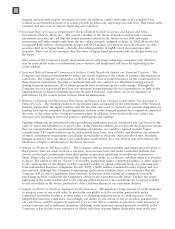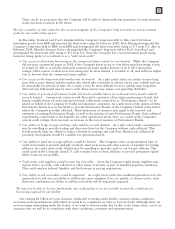Motorola 2008 Annual Report Download - page 20
Download and view the complete annual report
Please find page 20 of the 2008 Motorola annual report below. You can navigate through the pages in the report by either clicking on the pages listed below, or by using the keyword search tool below to find specific information within the annual report.
700MHz public safety systems in the U.S. and digital dividend spectrum worldwide, and (iv) continuing to lead the
market in APCO 25 and TETRA standards-based voice and data networking systems around the world. We
continue to actively manage our portfolio, investing to expand into attractive, complementary markets, and
divesting non-strategic businesses.
In the commercial enterprise market, our approach is to deliver products and services that are designed to
empower the mobile workforce to increase productivity, drive cost effectiveness, and promote faster execution of
critical business processes. Our solutions architecture focuses on three areas: (i) portfolio of devices and
applications that provide real time information at the point of business activity, (ii) enterprise wireless networks
that allocate seamless connectivity inside and outside the enterprise, and (iii) a set of management, security and
mobility tools that provide a controlled deployment of the enterprise mobility applications.
Customers
Our products and services are sold worldwide to a diverse set of customers, including government and public
safety agencies (police, fire, and emergency management services) and militaries, as well as retail, utility,
transportation and logistics, manufacturing, wholesale and distribution, healthcare and other commercial
customers. Our sales model emphasizes both direct sales by our in-house sales force and indirect sales through our
channel of value-added resellers and distributors. We believe this dual sales approach allows us to meet customer
needs effectively, build strong, lasting relationships and broaden our penetration across various markets. Our
channel sales force extends the reach of our products and services to meet demand in market segments where our
direct sales force does not sell. Resellers and distributors each have their own sales organizations which
complement and extend our sales organization. With deep expertise about specific customers’ operations, resellers
are very effective in promoting sales of the Company’s products. Our independent software vendor and value-
added resale channels offer customized applications that meet specific needs in each market segment we serve.
Our largest customer is the U.S. Government, which represented approximately 8% of the segment’s net sales.
The loss of this customer could have a material adverse effect on the segment’s revenue and earnings over several
quarters, because some of our contracts with the U.S. Government are long-term. Net sales to customers in North
America represented 57% of the segment’s net sales in 2008.
A majority of our sales are made directly by our in-house sales force, and the remainder of our sales are made
through global resellers and distributors. Given the current global economic conditions, we expect reduced
spending by certain customers, particularly retail, transportation and logistics, construction and manufacturing, to
continue into 2009.
Competition
The businesses in which we operate are highly competitive. Continued evolution in the industry, as well as
technological migration, is opening up the market to increased competition. Other key competitive factors include:
technology offered; price; availability of vendor financing; product and system performance; product features,
quality, availability and warranty; the quality and availability of service; company reputation; relationship with key
customers; and time-to-market. We believe we are uniquely positioned in the industry due to our strong customer
relationships, our technological leadership and capabilities, and our comprehensive range of offerings.
The segment experiences widespread competition in the government and public safety market from a growing
number of new and existing competitors, including large system integrators. In this market, the segment provides
communications and information systems compliant with both APCO 25 and TETRA industry digital standards.
Major competitors include: M/A-Com, EADS, Kenwood, EF Johnson and Cisco.
Large system integrators are seeking to move further into the public safety area, specifically in the federal
government market. Competitors in this segment, including the Company, may also serve as subcontractors to
large system integrators and are selected based on a number of competitive factors and customer requirements.
Where favorable to the Company, we may partner with large system integrators to make available our portfolio of
advanced mission-critical services, applications and devices.
Several other competitive factors may have an impact on the business, including: the consolidation among
telecommunications equipment providers, evolving developments in the 700 MHz band, and increasing
encroachment by broadband and IP solution providers and new low-tier entrants. As demand for fully-integrated
12


